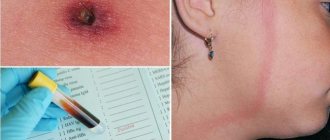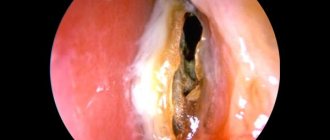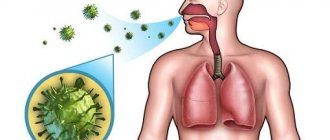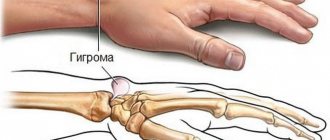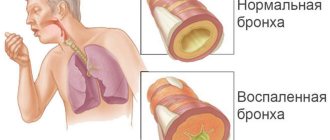Reasons for the formation of ulcers
To understand why ulcers appear on the tonsils (or tonsils), you need to imagine the structure of these paired palatal formations. They consist of lymphoid tissue dotted with lacunae or crypts. This is the name given to canals with holes on the surface that open into the oral cavity. The diameter of the holes ranges from 1 to 4 mm. They become the site of accumulation of purulent masses and the formation of white ulcers on the tonsils.
Photo: structure of the tonsils
The purpose of the tonsils is to create a barrier to infection that seeks to enter the larynx, trachea, bronchi and lungs. When the onslaught of bacteria becomes too strong, symptoms of inflammation appear in the pharynx: an ulcer on the tonsil or several small ulcers, an increase in the volume of the tonsils (hypertrophy), the formation of a white coating on them, purulent accumulations in the lacunae. These accumulations scar over time and turn into plugs .
All these are symptoms of diagnoses such as chronic tonsillitis, tonsillitis, mononucleosis, diphtheria or candidiasis (stomatitis). Various microorganisms cause infections:
- adenovirus;
- streptococcus;
- staphylococcus;
- Pneumococcus;
- gonococcus;
- chlamydia;
- diphtheria bacillus;
- fungi of the genus Candida.
To get rid of suppuration, it is important to understand which pathogen caused it - the treatment regimen will depend on this.
The only way to determine this is to analyze a swab from a sore throat. That is why it is important, without wasting time on self-medication, to quickly consult a doctor. Especially if a plaque, ulcer or abscess is noticed on the child’s tonsil. And even if the body temperature remains within normal limits and there is no acute sore throat.
Conservative therapy
Treatment of tonsillitis, which is aggravated by plugs, is aimed at alleviating symptoms and destroying the pathogen. The most commonly prescribed antibacterial agents are Amoxicillin, Cephalexin, and Oxacillin. The therapeutic course is about 10 days. Sometimes the doctor recommends the use of macrolides, for example, Sumamed, Erythromycin. Such medications cannot be treated for longer than 3 days.
For any inflammatory process, treatment of the lesion with antiseptic agents is indicated. Inflammation of the tonsils with the formation of tonsillitis plugs can be treated with the help of drugs: Furacilin, Rotokan, Miramistin, Chlorhexidine. Instead of solutions, antiseptics in the form of tablets and lozenges can be prescribed: Septolete, Faringosept, Strepsils.
If inflammation occurs with an increase in body temperature, antipyretic drugs are taken: Ibuprofen, Nurofen. And to relieve swelling of the mucous membrane of the tonsils - antihistamines, for example, Loratadine, Cetrin, Zyrtec.
To get rid of tonsillitis plugs forever, they need to be removed. Typically, the procedure is carried out in one of several ways: by washing, using a special apparatus or using surgery. The last option is the most radical. It is resorted to only as a last resort: if complications of purulent tonsillitis may appear.
This condition is characterized by a significant increase in sore throat. There is an increase in temperature to 40 °C and an increase in intoxication phenomena. The neck in the affected area swells, and usually the swelling appears on one side. There is no pus or tonsillitis in the visible area.
With lacunar angina, it is possible to remove purulent plugs by mechanical cleaning. The doctor presses the outer arch of the tonsil with a spatula - and liquid pus comes out.
Washing lacunae
Doctors rinse the tonsils using a syringe with a cannula at the end. Washing out is carried out after introducing the drug into the lacuna. The procedure is carried out 5 times, usually this is enough to remove all purulent formations. But the method may be ineffective if the passages of the gaps are too tortuous and deep.
Purulent tonsils: symptoms and treatment
In most cases, pustular lesions of the throat cause associated symptoms such as:
- pain when swallowing or persistent pain;
- purulent taste and bad breath;
- temperature increase;
- general malaise, weakness;
- swollen lymph nodes;
- nausea, vomiting, loose stools;
- headache and ear pain.
In this case, you should immediately call a doctor. Before his arrival or before visiting the clinic, all that can be done to alleviate the condition is drinking plenty of fluids, bed rest and gargling every hour with a glass of warm, weak solution consisting of soda (1/2 teaspoon), salt (1 teaspoon) and iodine ( 2 drops). A solution of Furacilin (a tablet in a glass of water) or a decoction of a plant with an anti-inflammatory effect is also suitable:
- calendula;
- chamomile;
- yarrow;
- oak bark;
- sage;
- eucalyptus;
- series;
- sagebrush.
Antipyretic drugs are recommended to be taken only at temperatures above 38 °C. You should not remove purulent plugs on the tonsils on your own; the inflammation may intensify. Moreover, you cannot self-prescribe the first antibiotics you come across. They may not only not help, but also cause harm, complicating further treatment.
Nutrition should be gentle, mostly liquid. It is necessary to remove spicy, sour and sweet foods from the diet during treatment.
It is forbidden to make compresses or warm up the inflamed tonsils in any other way - this will increase the proliferation of bacteria and the formation of pus.
Sore throat alone, which causes ulcers and ulcers on the tonsils as in the photo, comes in different types: lacunar, follicular, phlegmonous. In all these cases, treatment is carried out in a hospital setting with antibiotics of the penicillin group, and if they are powerless - with macrolides, fluoroquinols, cephalosporins.
Feverish symptoms are not always observed. In a number of diseases, ulcers appear on the tonsils without fever, and the throat does not hurt. But this does not mean that the situation can be left to chance.
What is bacterial tonsillitis?
A pathology such as bacterial tonsillitis often occurs. Every person has suffered from a cold at least once in their life. One of their manifestations is inflammation of the tonsils. The latter are located in the oral cavity. This is a collection of lymphoid tissue. Most often, inflammation of the tonsils is observed. If it occurs in an acute form, this condition is called angina. In the absence of proper therapy, inflammation can become chronic. It is much more difficult to cure. What is the etiology, clinical picture and treatment of bacterial tonsillitis?
Features of bacterial tonsillitis
Inflammation of the tonsils can occur in children and adults. Most often, the disease is infectious in nature. In most cases, a bacterial form of inflammation is diagnosed. Less commonly, tonsillitis is caused by viruses (measles, scarlet fever, diphtheria). Inflammation of the tonsils can be acute or chronic. The first, depending on the prevalence of inflammation, is divided into the following forms:
- lacunar;
- sclerotic;
- parenchymal;
- lacunar-parenchymatous.
The clinical classification distinguishes simple and toxic-allergic forms of inflammation. As for acute bacterial tonsillitis (tonsillitis), it can be catarrhal, lacunar, follicular, fibrinous, phlegmonous, ulcerative. There is also a herpetic form of the disease.
Etiological factors
In more than half of cases, sore throat is caused by streptococci and staphylococci. Beta-hemolytic streptococcus is of greatest importance in the development of this pathology.
This also applies to chronic tonsillitis. The following bacteria play a secondary role in the development of inflammation: pneumococci, moraxella, Haemophilus influenzae, anaerobes. People with chronic tonsillitis often experience a mixed infection (a combination of streptococci and staphylococci). Most bacteria live in the oral cavity of healthy people. However, there are no signs. In children and adults, inflammation of the pharyngeal and palatine tonsils is promoted by decreased immunity. Predisposing factors may be:
- hypothermia;
- colds;
- traumatic injury to the tonsils;
- burns of the oral mucosa with hot food or water;
- difficulty in nasal breathing;
- the presence of chronic infections (caries, sinusitis);
- diseases of the nervous system.
The cause of tonsillitis can be a viral infection (influenza, ARVI, measles, scarlet fever, adenoviral infection). It is important that bacterial tonsillitis is a contagious disease. In close contact with sick people (kissing, talking), infection is possible.
Acute tonsillitis
Symptoms of acute tonsillitis depend on the form of the disease. Very often, patients are bothered by both general and local symptoms. The surface of the palatine and pharyngeal tonsils has small depressions (lacunae). In these places, purulent contents most often accumulate. Common signs of sore throat are:
- increase in body temperature to 39°C and above;
- joint pain;
- weakness;
- malaise;
- tearfulness (typical of children);
- sleep disturbance;
- anxiety;
- muscle pain;
- headache.
In severe cases, children may experience confusion, seizures, nausea, and difficulty breathing. Most often, these clinical signs are due to the development of complications. Local manifestations of angina are:
- a sore throat;
- swollen lymph nodes;
- difficulty swallowing food and saliva;
- ear pain;
- hypersalivation.
Catarrhal tonsillitis is most often diagnosed.
It is characterized by an acute, sudden onset. Patients may complain of a burning sensation in the throat, sore throat, and moderate pain. The temperature rises slightly (up to 38°C). A medical examination reveals redness of the tonsils and their enlargement. Mucopurulent films may be detected. With follicular angina, the condition of patients is more severe. The leading symptom is severe pain, which can radiate to the ear area. Signs of intoxication of the body are clearly expressed. Children may experience nausea and vomiting. Upon examination, small yellowish dots are visible on the mucous membrane of the tonsils. A feature of lacunar tonsillitis is the presence of a yellow-white coating. This form of acute tonsillitis is somewhat more severe than the previous one. Fibrinous tonsillitis is the most difficult to resolve. It is often accompanied by signs of central nervous system damage. The main symptom is the appearance of local fibrinous plaque on the tonsils. In the ulcerative form of inflammation, necrosis of the tonsil occurs. Patients are concerned about the sensation of a foreign object in the throat, bad breath, and pain.
Chronic tonsillitis
Viral or bacterial tonsillitis, occurring in a chronic form, is characterized by the following symptoms:
- redness of the throat;
- thickening of the edges of the arches;
- damage to the cervical and submandibular lymph nodes;
- thickening of the tonsils;
- the presence of pus on the tonsils.
This form of tonsillitis occurs in waves with periods of exacerbation and remission.
The first is similar to the manifestations of a sore throat. At the same time, the temperature may rise and a sore throat may appear. Often chronic tonsillitis is associated with other diseases (rheumatism, lupus, dermatomyositis, eczema, Behçet's disease, thyroid pathology).
Recurrences of tonsillitis can occur several times a year. There are compensated and decompensated stages of chronic tonsillitis. In the first case, there are complications in the form of damage to the heart and its valves, joints, and kidneys. Chronic tonsillitis, which occurs with pronounced general symptoms, is called toxic-allergic.
Diagnostic measures
The doctor must know not only the causes of bacterial tonsillitis, but also the diagnosis of this pathological condition, which includes:
- taking anamnesis;
- examination of the mouth and neck;
- laboratory testing (blood and urine tests);
- blood test for C-reactive protein and rheumatoid factor.
In order to identify the causative agent of the infection, a swab is taken from the throat. A PCR study is being carried out. In this situation, it is necessary to exclude the presence of diphtheria.
When interviewing a patient, it is of great importance to establish the cause of inflammation of the tonsils (hypothermia, infectious diseases).
An examination of the oral cavity plays an important role in making a diagnosis.
With angina, plaque or ulcers are most often found on the tonsils.
In chronic tonsillitis – gray-yellow plugs and changes in the tonsils. Differential diagnosis of bacterial tonsillitis is carried out with other diseases accompanied by sore throat (infectious mononucleosis).
Purulent tonsils without fever: diagnoses, treatment
Sore throat is not always accompanied by fever and severe malaise. For this reason, many do not complete the treatment of this terrible disease. This is where the development of chronic tonsillitis begins. This is the most common disease in which an abscess on the tonsil appears without fever and does not hurt, but poses a serious threat to the body.
Photo: chronic tonsillitis
With chronic tonsillitis, the tonsils become inflamed at the slightest hypothermia, exposure to infection, or are constantly in an inflamed state. Toxins, which are waste products of pathogens, enter the bloodstream and systematically poison the entire body, causing allergic reactions. This leads to a decrease in immunity, against the background of which a person becomes vulnerable to any infections. It turns out to be a vicious circle.
If there are ulcers on the tonsils and there is no temperature, treatment without medical supervision is also unacceptable. Chronic diseases are not treated with antibiotics so as not to further disturb the bacterial balance. Instead, local antiseptic drugs are prescribed: Grammidin, Miramistin, Lugol, Dioxidin, Octinecept. As well as therapeutic rinses and medicinal inhalations with a nebulizer.
Washing the tonsils with the “tonsillor” apparatus
At the same time, local immunity is activated with Immudon tablets or natural remedies: ginseng, propolis, pantocrine.
In addition to such conservative treatment methods, specialists in clinics also use modern ones:
- washing of festering lacunae with the “tonsillor” apparatus;
- laser therapy;
- ultrasonic irrigation;
- ultraviolet irradiation;
- vibroacoustic impact.
If, despite all efforts at systemic treatment, chronic tonsillitis worsens more than four times a year, the affected tonsils apparently cannot be cured and will have to be removed: instead of a barrier to the infection, they themselves have become its chronic focus.
In addition to tonsillitis, pus without fever can also cause other diseases . That is why before starting treatment, the doctor must establish the correct diagnosis. Sometimes people think, when they see white pustules on the tonsils, that it is a sore throat and swallow antibiotics, but the analysis shows that it is candidiasis, which can only be gotten rid of with antifungal drugs.
What does fungal sore throat look like?
This sore throat is also called candidiasis because it is formed due to the pathogenic activity of the Candida fungus. The disease is characterized by the presence of a cheesy, pale yellow or white coating in the pharynx, which can be easily removed with a regular spatula. After this, small bleeding wounds appear on the tonsils.
Some time after clearing the throat, the plaque appears again. Without appropriate therapy and with good immunity, the plaque may acquire a grayish color. This indicates that the body is actively fighting the disease.
With weakened immunity, this plaque acquires a brown tint with scarlet substrates. This indicates that the fungus has penetrated the glandular tissue of the tonsils.
Complications of purulent lesions of the tonsils
Self-medication of sore throat, chronic tonsillitis and other diseases that result in the formation of purulent plugs in the tonsils can undermine a person’s health for the rest of his life. As well as a negligent attitude towards this problem, especially if it does not bother you much during a chronic course.
The fact that an abscess on the tonsil is not accompanied by fever and does not hurt does not mean that its presence can be tolerated. This can lead to life-threatening local phenomena such as abscess, abscess and sepsis. And also cause systemic complications caused by the constant entry of toxins and particles of pus into the lymphatic and bloodstream:
- lymphadenitis;
- sinusitis;
- sinusitis;
- pyelonephritis;
- rheumatism;
- endocarditis;
- polyarthritis;
- adnexitis;
- prostatitis;
- cholecystitis.
An untreated sore throat can result in the same consequences when, after the acute symptoms have been relieved and the general condition has improved, the patient independently stops the medication course and observation by a doctor. Meanwhile, the inflammatory process quietly progresses and moves into a new stage of exacerbation or into a chronic form.
As long as there is at least one ulcer or abscess on the tonsil, treatment should not be stopped. Moreover, some purulent plugs and ulcers can only be noticeable during a medical examination.
What does ulcerative membranous tonsillitis look like?
This type of tonsillitis is characterized by the presence of a grayish or light yellow coating on the tonsils, which is almost impossible to remove with a spatula. The islands of rashes have a round shape. The oropharynx turns red. The palatine arches enlarge and hang over the entrance to the pharynx.
The surface of the film is surrounded by a characteristic inflamed rim. If you still remove the filmy coating, you can see the infected surface with small round ulcers of a yellowish tint.
Sometimes ulcers spread to the gums, periosteum and even the tongue. In this case, loosening of the mucous membrane may occur.
Prevention of purulent tonsillitis and chronic tonsillitis
If even a small amount of pus is noticed on the tonsils, treatment should be completed and secured with a restorative course. Only this will protect against tonsillitis becoming chronic.
After antibiotic therapy, it is necessary to take drugs with bifidobacteria and lactobacilli. To restore the local bacterial balance, it is useful to gargle with fermented milk products such as Narine.
Only an organism with high immune defense can independently fight streptococci, staphylococci and another three dozen types of pathogens that cause pustules on the tonsils. To do this you need:
- Adequate nutrition with a sufficient amount of protein products in the diet: meat, offal, fish, milk, dairy products, as well as herbs, fruits and vegetables.
- Replacing tea and coffee with herbal and fruit and berry restorative infusions.
- Hardening, which will help you endure hypothermia. And these are not only procedures that harden the entire body, but also local ones: for the throat. The procedure consists of gradually (by 0.5 degrees daily) reducing the temperature of drinks and rinses.
- Timely treatment of caries and other diseases of teeth and gums.
- A healthy and active lifestyle with no smoking and alcohol abuse, exercise and a positive attitude.
These simple rules will ensure health for many years and will help you endure infectious diseases without dangerous consequences.
Abscesses on the tonsils, plaque of different colors, red throat - all these are signs of acute or chronic inflammation in the nasopharynx, oral cavity, symptoms of a fungal infection. The reasons for the appearance of such symptoms in adults and children may be different; traditional and folk remedies are used in treatment. In advanced cases, surgery may be required.
Ulcers on the tonsils are a sign of an inflamed nasopharynx
Causes of ulcers on the tonsils
The most common cause of the appearance of purulent plugs in the openings of the tonsils is the lacunar and follicular form of tonsillitis; diseases develop when the body is damaged by viruses and bacteria. The diseases are accompanied by fever, sore throat, and signs of intoxication. In severe types of pathology, ulcers form on the tonsils, plaque takes on a green tint, and a rotten smell appears from the mouth. You can see what diseased tonsils look like in the photo.
Tonsils with ulcer plugs
Why does pus and plaque appear on the tonsils:
- Lacunar tonsillitis - yellow or white ulcers appear in the lacunae (funnels on the surface of the tonsils), they can be extensive, merge with each other, and cover all the tonsils.
- Follicular sore throat - the throat turns red, swells, small purulent blisters with clear boundaries appear on the tonsils, which can open on their own, white or yellow pus is released.
- Chronic tonsillitis - liquid pus with a curdled consistency, white dots or yellow plugs are present in the lacunae of the tonsils almost constantly. When you lightly press on the contents of the tonsils with a hard object, it is easily separated, an unpleasant odor appears from the mouth, the throat practically does not hurt, but the presence of a foreign body in the throat is clearly felt. This disease can only be completely cured through surgery.
- Pharyngocandidiasis is a fungal infection, damage to the tonsils by yeast fungi. The disease develops against the background of long-term antibacterial therapy, weakened immunity, and is accompanied by the appearance of white streaks on the tonsils.
- Cysts are benign neoplasms that outwardly resemble an encysted abscess, but they do not contain pathogenic microorganisms. The disease is accompanied by a sore throat and the swallowing process is difficult.
- Dental pathologies - periodontal disease, caries can cause the appearance of ulcers with a white coating, which are similar in appearance to pustules on the tonsils.
- Laryngitis, pharyngitis - pathologies arise due to hypothermia, the voice becomes hoarse, pits and tubercles appear on the mucous membrane, and the person is bothered by coughing attacks.
Laryngitis is one of the reasons for the appearance of ulcers on the tonsils
Purulent inflammation, white plaque, holes on the oral mucosa and the surface of the tonsils can appear due to injuries - the delicate tissue of the tonsils can be injured by bone, stale crust of bread. If the immune system works well, then damaged tonsils are quickly restored. In children, plaque on the tonsils can be caused by drinking milk or fermented milk products - you just need to gargle with warm water.
What does catarrhal sore throat look like?
Catarrhal type is considered the mildest form of tonsillitis. With properly selected therapy, complete recovery occurs within 7 days.
The characteristic signs of catarrhal tonsillitis are:
- hyperemia of the mucous membrane of the tonsils;
- enlargement of the small tongue and free edge of the arches of the palate, which hang over the entrance to the pharynx;
- redness of the soft palate;
- swelling of the throat;
- leukocyte infiltration of the parenchyma with small foci;
- thickening of the epithelium on the surface of the tonsils and its partial desquamation;
- small mucus compartment.
Also, with catarrhal tonsillitis, the lymph nodes become enlarged.
Diagnostics
After an initial examination to confirm the diagnosis, the doctor prescribes tests; based on the results, you can find out the cause of the inflammatory process and select the right medications.
Basic diagnostic methods:
- clinical and biochemical blood test - shows the presence of an inflammatory process;
- general urine analysis;
- a smear from the tonsils to examine the contents;
- pharyngoscopy.
Pharyngoscopy is used to examine the condition of the tonsils.
When to see a doctor: how an ENT removes pus from the tonsils
You need to contact an ENT doctor:
- With extensive raid.
- Pus on the tonsil on one side.
- In case of a pronounced systemic reaction of the body (fever, chills, sweating).
- Ulcers appear regularly.
The doctor decides how to remove the plugs and how to clean the tonsils during the examination.
To remove pus from the tonsils, the ENT doctor uses:
1
Sanitation of the tonsils - washing the lacunae with a syringe or sucking out the pus using a vacuum method. Using a special syringe, the doctor rinses the lacunae with antiseptic substances under pressure. This is the most common and accessible method.
The vacuum method is more effective. Using a special device, pus is sucked out of the tonsils. The cleaned lacunae are filled with medicine.
2
Physiotherapy helps cleanse the tissues in the throat, reduces swelling and inflammation. There are several types of physiotherapy used to treat the ENT organs.
Ultraviolet irradiation
- has a bactericidal effect, helps remove pus from the tonsils during tonsillitis.
Laser exposure
has an antimicrobial effect, improves blood and lymph circulation in inflamed tissues.
Ultrasound is a method
with the help of which drugs with a therapeutic effect (antibiotics, hydrocortisone, dioxidine) are introduced deep into the soft tissues.
3
Laser cryptolysis is a promising method for treating tonsils using radio waves. The essence of the method is to clean the crypts from foreign substances, sterilize them, and then seal them. The method allows you to get rid of plaque in 2-3 approaches completely and for life.
Diagnostics
Diagnosis of diseases begins with detailing complaints and collecting anamnesis. An ENT doctor can make a preliminary diagnosis by examining the pharynx, assessing the condition of the throat and the nature of the plaque.
Identification of the pathogen that caused the disease is mandatory. For this, a throat swab is prescribed.
If necessary, additional studies are prescribed.
General blood analysis
allows you to determine the body's response to the inflammatory process.
Blood chemistry
with the detection of C-reactive protein, antistreptolysin-O, rheumatoid factor is prescribed if a streptococcal etiology of the disease is suspected.
Electrocardiography
may be needed to assess heart function in complicated diseases.
How to treat ulcers at home
To eliminate infection and inflammation in the tonsils, medications are used that remove pathogenic microorganisms and help strengthen the immune system. As additional methods, you can use alternative medicine recipes. If the ulcers are persistent and the patient’s well-being does not improve during treatment, surgical treatment methods are resorted to.
Treatment with drugs
The basis for the treatment of acute purulent process in the tonsils is antibacterial drugs. Without proper treatment, against the background of a purulent-inflammatory process, concomitant pathologies begin to develop - acute rheumatic fever, which is accompanied by damage to blood vessels, heart, joints, abscess, otitis media, hearing impairment, blood poisoning.
How to remove pus from tonsils:
- antibiotics from the penicillin group - Flemoxin Solutab, Amoxicillin, the drugs are not very strong, but they can treat a child, the use of these drugs during pregnancy is allowed;
- antipyretics - Paracetamol, Ibuprofen, they should be used if the temperature rises above 38.5 degrees;
- antiseptic solutions for rinsing - Miramistin, Furacilin;
- sprays with analgesic, antibacterial and anti-inflammatory effects - Ingalipt, Hexoral, Bioparox, Lugol;
- lozenges – Lizobakt, Faringosept;
- antihistamines – Erius, Tavegil to eliminate swelling;
- vitamin complexes, immunomodulators to strengthen the body's protective functions.
Traditional methods
Before using traditional medicine recipes, it is recommended to consult with your doctor.
Among the most common methods are:
- Applications. You can take cereal or sea salt and heat it, pour it into a bag and apply it to a sore throat. It is recommended to use natural fabric, wool especially helps, reducing the inflammatory process on the tonsils
- Soda-salt solution. You can add and combine the following ingredients: sea and table salt with the addition of a few drops of iodine. To achieve optimal results, it is recommended to gargle and rinse the nasal cavity
- Gargling with horseradish and aloe juice. It is enough to combine both components and gargle with the solution. Helps get rid of harmful germs
- Decoctions are no less useful. It is recommended to use oak bark, calendula, burdock and sage. For maximum effect, rinse three times a day.
Prevention
To prevent the appearance of ulcers on the tonsils, you should minimize the likelihood of developing respiratory tract disease.
How to protect your throat:
- Ice cream and cold drinks should be consumed slowly in small portions.
- Strengthen your immune system - harden yourself, exercise regularly, spend more time in the fresh air, give up addictions.
- Do not neglect dental problems, fill all holes in the teeth in a timely manner, and eliminate nasopharyngeal diseases.
- Avoid hypothermia.
- Observe hygiene standards and regularly carry out wet cleaning of your home.
To avoid severe complications of the throat, it is necessary to get an annual flu vaccine - the vaccine should be administered several months before the outbreak of the epidemic.
Purulent and infectious processes in the tonsils are diagnosed in people of different ages; the risk group includes the elderly, children and pregnant women. Timely diagnosis and proper treatment can avoid serious complications, and following simple rules of prevention can reduce the likelihood of developing inflammation in the tonsils.
Rate this article ( 4 ratings, average 5.00 out of 5)
Tonsil abscess is a severe complication of acute bacterial tonsillitis. Doctors say that the main reasons for the development of an abscess are severe hypothermia during a period when the body has not yet fully recovered from a sore throat. The disease is very dangerous and requires urgent treatment. If you suspect an abscess, you should immediately see a doctor.
Types of abscess
An abscess can occur both in the tonsil itself and in neighboring areas
Gland abscesses are a cavity filled with pus. This is a dangerous source of infection in the body, since when an abscess is opened, purulent masses can spread to other tissues and internal organs.
The following types of pathology are distinguished:
- paratonsillar - inflammation of the pharynx around the tonsils;
- retropharyngeal – abscess in the retropharyngeal zone;
- intra-almond - located in the gland itself.
An intra-almond abscess is also called a tonsillar abscess and is a direct consequence of acute tonsillitis.
Depending on the location, the abscess can also be posterior, inferior, anterior and external. This determines the location of the abscess relative to the pharynx.
What does follicular sore throat look like?
With follicular tonsillitis, the center of inflammation is located in the follicles of the tonsils. It is in them that pus is produced, which is visible through the mucous membrane. The tonsils seem to be strewn with small yellow-white islands. Further, large areas are formed on them, covered with a light fibrinous plaque with vesicles, this is caused by the active release of fibrin. There is pus inside the blisters.
Sometimes fibrinous films are connected to each other, forming the so-called confluent plaque. In the presence of concomitant diseases of the circulatory system, an increase in lymphatic vessels and mild thrombosis of the tonsillar veins may be observed in the throat. With reduced immunity, ulcers can even break into the throat.
Causes of development of tonsil abscess
In the vast majority of cases, we are talking about peritonsillar abscess; other types are very rare. The main reason for the development of suppuration is acute purulent tonsillitis, which has not been completely cured. The infection then spreads to the tissue around the tonsils, forming a large abscess that causes severe symptoms.
Another cause may be acute bacterial pharyngitis caused by streptococci or staphylococci. The causative agent of the disease can be accurately determined by analyzing a throat smear.
Factors predisposing to the development of an abscess:
- improper treatment of sore throat;
- smoking;
- decreased immunity;
- hypothermia;
- uncontrolled use of antibiotics.
Acute tonsillitis is treated with antibacterial drugs. Medicines are selected by the doctor individually for each patient. When taking antibiotics, it is important to strictly follow the doctor's recommendations regarding the dosage regimen and duration of therapy. If the patient begins to take medications uncontrollably, reducing or increasing dosages, or skipping pills, they simply stop working properly. As a result, the body experiences stress due to the medication, immunity decreases, and bacteria develop resistance to the medication. Against this background, the risk of complications of tonsillitis increases, including the development of paratonsillar abscess of the tonsils.
Smoking during tonsillitis treatment is another factor that increases the risk of complications. In this case, the reason lies in the additional deterioration of local immunity due to the action of tar and nicotine.
After any infectious disease, the body needs time to recover. If severe hypothermia occurs immediately after treatment for a sore throat, there is a high risk of relapse of the disease. But, since the body is greatly weakened and cannot fight the infection on its own, the sore throat worsens more severely and an abscess develops.
Tonsillitis plugs: what are they?
They are an accumulation of dead cells (foreign and own) and products of their decay.
When stored for a long time, they change their structure due to the deposition of calcium salts.
Tonsillitis stones can be single or multiple. Their size starts from 1 mm and in some cases ends at several centimeters.
Depending on the composition and duration of existence, tonsillitis can be yellow, gray, reddish and even brownish.
Not every pus has time to calcify. In the early stages, white, loose lesions of small size are identified.
Symptoms of pathology
The disease is accompanied by pain in the ears
Peritonsillar abscess of the tonsil, or phlegmonous tonsillitis, has the following symptoms:
- acute excruciating pain during swallowing;
- heat;
- severe symptoms of body intoxication;
- difficulty swallowing due to swelling;
- noticeable enlargement of the mandibular lymph nodes;
- inability to open your mouth wide;
- difficulty breathing (in case of retropharyngeal abscess);
- discomfort in the ears - aching pain, feeling of pressure.
Treatment of tonsil abscess
Treatment of tonsil abscess is carried out conservatively or surgically. In most cases, doctors recommend opening a purulent abscess of the tonsil, as this will get rid of the problem very quickly. However, this method has a number of contraindications, so it is not suitable for everyone.
Drug treatment
Surgery
The tonsil abscess is opened surgically no earlier than 5-6 days after the onset of the acute inflammatory process. This is due to the fact that the abscess must mature and the cavity must fill with pus.
The procedure requires anesthesia. The doctor injects lidocaine or another anesthetic into the throat, so the patient does not feel anything while removing the abscess. After the anesthetic begins to act, the abscess is opened with a scalpel and drainage is installed, with the help of which the cavity is completely cleared of pus. The duration of the procedure depends on the size of the abscess and the amount of contents.
After the cavity is cleaned, the doctor lubricates the resulting wound with an antiseptic solution and prescribes medications.
An important question that worries patients is when can they eat after removal of a cellulitis or abscess of the tonsils. The doctor will give the exact answer to this question, since everything depends on the size of the abscess and the resulting wound. However, in the first days, strict dietary restrictions are imposed - you cannot eat hot or cold food, anything spicy or salty.
Rehabilitation after opening an abscess
Any alcoholic drinks during the recovery period are strictly contraindicated
When doctors open a tonsil abscess, they leave the wound open without stitches. Tissues regenerate quite quickly, but a number of recommendations must be followed for effective recovery.
- Take antibiotics prescribed by your doctor for 7-10 days. This is necessary in order to minimize the risk of re-development of the abscess.
- Until the tissue is restored, do not eat hot, cold, salty or spicy foods. Food should be soft so as not to injure the tonsils. In the first 4-5 days, the sore throat does not go away.
- To speed up recovery, gargles are prescribed. This procedure should be carried out regularly, using only those medications recommended by the doctor. After surgery, rinsing with salt or soda is prohibited, as it irritates the tissue and disrupts regeneration.
- Under no circumstances should you warm up a throat abscess, otherwise complications cannot be avoided.
For the entire rehabilitation period, it is prohibited to drink hot and cold drinks, drink alcohol and smoke.
During the rehabilitation period, the patient must be examined by an otolaryngologist every 3-4 days.
Features of the treatment of bacterial tonsillitis
For bacterial tonsillitis, treatment should not be started, but should be started as early as possible. Tonsillitis may be accompanied by a sore throat and body aches. The disease is characterized by inflammation of the tonsils. The state of the immune system depends on their work.
Main causes and signs of appearance
There are two different types of disease that should not be confused, because they require completely different treatments:
- Bacterial sore throat. The condition of the tonsils changes, follicles form, and pus accumulates. You cannot do without antibiotics and removal of purulent formations.
- Viral tonsillitis. Enlarged tonsils. The causes are very similar to bacterial. It can be cured much faster with antibiotics.
When bacteria enter the body, they do not immediately become active, so a person can remain a carrier for some time, infecting other people.
Sore throat can be caused by problems with the respiratory tract: the formation of adenoids, polyps, or distortion of the septum. Even if you get sinusitis, bacterial tonsillitis may subsequently develop. Lack of vitamins, allergic reactions and aggressive environmental factors are the main indicators for reducing human immunity and can become causes for the development of diseases.
The following symptoms are identified that prove the presence of streptococcus bacteria:
- a sharp increase in temperature without any other signs of illness;
- pain when swallowing;
- aches throughout the body, especially aching pain in the lower extremities;
- general malaise. Appetite disappears, apathy, lethargy, and a feeling of exhaustion appear;
- White formations are visible in the throat - purulent plaque. In addition, inflamed tonsils may be observed;
- severe redness of the inner surface of the throat;
- unpleasant pungent odor from the mouth;
- headache.
Methods of treating the disease
It is impossible to treat tonsillitis without resorting to drug therapy; first of all, antiseptic drugs are prescribed.
The essence of the treatment is to remove purulent formations on the tonsils and prevent the formation of plugs with pus. An important effect is the relief of inflammation and pain, therefore, for quick and high-quality treatment, the doctor, in addition to conventional medications, must prescribe antibiotics aimed at destroying the staphylococcus bacteria (Amoxicillin, Penicillin, Cefadroxil, Oxacillin). In addition, a complex therapy specialist will add painkillers to relieve the pain effect. This could be Paracetamol, Ibuprofen.
It is not recommended to treat on your own, but you can use folk remedies: rinsing with medicinal herbs (chamomile) or solutions of soda and salt, Furacilin, Chlorhexidine. A decoction of sage and tincture of calendula are perfect for rinsing, relieving irritation and pain.
Particular attention should be paid to the patient's nutrition. During this period, the body requires vitamins. The diet should include steamed vegetables: cabbage, carrots, beets, beans. Fruit compotes, jelly, and rosehip decoction help restore immunity well. To saturate the body with fats, you need to eat soups and boiled pieces of chicken fillet. Serve all food in small pieces or puree it so as not to injure your throat. Avoid hot and cold food.
Sometimes the disease can develop into a new form - chronic. Treatment in this case will be long and difficult. After such tonsillitis, negative consequences are possible: dermatomyositis, rheumatism, skin diseases: psoriasis, eczema, diathesis. The therapy will be gradual: first, tonsillitis is treated, and then the manifested pathologies.
Treatment with folk remedies
Treatment with traditional methods will help alleviate the suffering of the patient. The main ways can be:
- Removal of purulent formations. Active gargling, then lubricate the tonsils with Lugol's solution. Washing can be done with a decoction of chamomile, sage, or plantain.
- In the morning on an empty stomach, eat a spoonful of honey, which will soothe a sore throat. At night you need to drink mint tea, which will ensure sound sleep and have an anti-inflammatory effect. Before going to bed, you need to put hot compresses on your neck and cover it with a scarf to retain heat.
- Aromatherapy. Inhalations and aromatherapy speed up the healing process. Use essential oils of eucalyptus, lemon, cinnamon, ginger, rosemary, and fir.
- Throat massage. Mint ointments are easy to rub into the skin of the neck.
- Drink rice water before meals, which will protect the throat and tonsils from damage.
It is possible to cure tonsillitis at home if the form is not acute, when the disease is just beginning to develop.
Bacterial tonsillitis can be treated quickly if you follow all the rules. To prevent the development of the disease, you should adhere to basic preventive rules: do not overcool, include vitamins in your diet, exclude harmful foods and lead a healthy lifestyle.
lor03.ru
How dangerous is a tonsil abscess?
Abscess of the tonsils can lead to chronic tonsillitis. If the cavity is not completely cleaned, there is a high risk of re-formation of a purulent abscess after a few days. In this case, the cavity is re-drained.
If the abscess opened on its own and no therapeutic measures were taken (the patient did not see a doctor), the following complications are possible:
- sepsis – blood infection with purulent masses;
- bacterial infection of the larynx;
- laryngeal stenosis;
- development of pneumonia.
Prevention and prognosis
An abscess can be treated quite successfully, provided that you seek qualified help in a timely manner and follow the doctor’s recommendations. However, quite often the abscess is replaced by chronic tonsillitis, associated with the active proliferation of pathogenic microorganisms in the tonsils. In this case, complex treatment is necessary, including regular sanitation of the lacunae of the tonsils, or the tonsils will have to be removed.
Prevention of abscess is measures to strengthen the immune system. It is necessary to promptly treat any infectious diseases in order to prevent a decrease in the body’s immune defense, otherwise the first blow will be on the tonsils.
Be sure to regularly visit the dentist, treat caries, brush your teeth thoroughly and rinse your mouth. Tartar is a favorable environment for the growth of bacteria, which also spread to the tonsils.
Since an abscess is most often a complication of untreated acute purulent tonsillitis, you must trust your doctor and not try to cure the disease with folk remedies. An abscess is a very dangerous phenomenon that can lead to serious complications, so it must be treated only under the supervision of an otolaryngologist.
«>
Methods for clearing tonsils
How to clean tonsils at home
- Rinse. You can use solutions of chlorophyllipt, furatsilin, soda, chamomile, lugol, chlorhexidine, hydrogen peroxide. You need to gargle at least five times a day for best results.
- Mechanical cleaning. A bandage soaked in antiseptic is wrapped around the finger. Scraping movements are made along the surface of the tonsils. Most often, such manipulations cause unbearable pain, so people choose other methods. The second option is to press a disinfected spatula onto the surface near the abscess, and it should flow out. Such cleaning of the tonsils at home is not only very painful, but also dangerous, since you can seriously injure the mucous membrane and further cause infection. This leads to the formation of an abscess. But if such a manipulation does take place, it is necessary to dissolve the streptocide tablet after it to prevent infection.
- Inhalations using decoctions of medicinal herbs. This cleaning of the tonsils at home is carried out in conjunction with rinsing.
- Irrigator for cleaning tonsils. The steps can be performed at home, but you should be aware that the percentage of mucosal injury is high. This is a dental device that is usually used to clean the spaces between teeth. It is also effective for clearing plugs in the tonsils, since under water pressure they are washed out well.
Traditional methods of cleaning tonsils
They are more gentle, especially if local anesthesia is used. The most important thing is that traditional methods are safer.
- Douching. You need a special syringe that is filled with a rinsing solution. You need to point it at the plug area and click on it. Thus, the pus is washed away, and the lacunae of the tonsils are cleansed. The ENT doctor has such a syringe. Therefore, you should contact him for this procedure, as he can carry it out less painfully and more effectively. But there are also disadvantages. The cannula of the syringe has a certain size, which does not allow the tiniest plugs to be cleaned out. Microorganisms under pressure can penetrate even deeper, and if the doctor does not notice this, a new plug is formed, which becomes deeper. After the procedure, small wounds remain, which after some time are covered with scar tissue.
- Vacuum cleaning of tonsils. The Tonsillor device is used. The device sucks out the plug and all pathogenic flora. But to complete the result, it is necessary to wash the resulting lacunae with an antiseptic, otherwise the infection may develop again. The method is painful.
- Ultrasonic washing. Ulcers are removed using a waveguide. Next, the drug is delivered to the canal and processed. This method effectively relieves inflammation, swelling and removes infection. The wound heals quickly as blood circulation improves. At the moment this is the most effective and safe method. Before and after the session you should not eat or drink for several hours. The course consists of ten sessions. In the first of them, the tonsils are only treated with ultrasound, this is done so that the lacunae expand and the pus begins to flow out. In subsequent sessions, phonophoresis is performed. But there are some contraindications for which such therapy is not possible: retinal detachment, first and last trimesters of pregnancy, hypertension, acute infection, tuberculosis, cancer.
Drug therapy. Treatment with hydrocortisone is usually given after ultrasound treatment. Before the session begins, anesthesia is administered to block the swallowing reflex. Hydrogen peroxide therapy is also possible. The drug is applied to the tonsils and sucked out using a special device. Lymphoid tissue is saturated with oxygen, which is released through an oxidation reaction.

